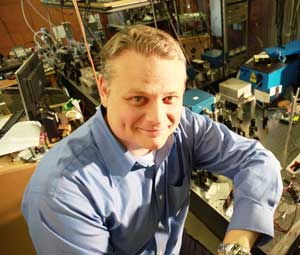About This Webinar
Additional questions and answers:
Q: What is the power intensity for the adjusted supercontinuum Stokes laser?
A: There are at least two PCF modules commonly used for supercontinuum Stokes generation. The multiplex-CARS (M-CARS) community and the spectral focussing CARS (SF-CARS) community generally use different fibres, and thus each utilize different power intensities across the usable wavelength range. We use a supercontinuum Stokes beam that spans 950 to 1150 nm, with a peak at around 1050 nm. The peak power density is on the order of 50 to 100 µW/nm. Off peak, we have made use of Stokes power densities as low as 5 µW/nm. Ideally, we would prefer a uniform intensity continuum with power density greater than 100 µW/nm.
Q: Why is fiber laser intensity not enough?
A: Available laser power is
not the predominant limiting factor that is limiting the widespread use of fibre laser sources in CARS/SRS microscopy. The main limiting factors are the synchronization of fibre-laser sourced pump and Stokes pulses, and furthermore the rapid and independent wavelength tuneability of these pulses. I believe that the technology is currently sufficiently mature to allow for excellent CARS/SRS microscopy to be conducted with integrated fibre-laser systems, and we are poised to see proliferation of such laser sources over the next few years.
Q: Paraffin sectioning could mess up attempts to work with lipids?
A: Absolutely. This is an important reason why experienced histologists have been slow to endorse the use of CARS/SRS for supplemental histological diagnostics, as many sample preparation systems use paraffin fixing. There are other means of fixing biological samples that do not utilize paraffin, and these are preferred if CARS is to be used. However, analysis of the vibrational spectrum outside of the CH region (say, in the fingerprint region) suffers much less from paraffin contamination.
Q: Are there any limitations on laser power associated with possible photoionization of the cell cultures?
A: Yes and no. Photoionization is not very likely at any powers one would use for CARS imaging. However, there are a multitude of nonlinear possesses that can rapidly lead to cell damage and death, and these can easily be observed with the kinds of pulse intensities commonly
used for CARS/SRS imaging. Moving deeper into the IR (further away from 800 nm, for example) rapidly mitigates these multiphoton processes.
Q: Technically I feel I have the ability to implement CARS or any other nonlinear spectroscopy. But being an optics/laser person, I found it hard to find an application, say a biological or biomedical problem, which I can solve when thinking about my faculty application. Could you please advise on this?
A: Welcome to the club! From your standpoint, the only solution to this problem is to work closely with doctors and biochemists/biologists — as well as any other scientist — to learn about their main problems and then gauge whether coherent Raman techniques can help solve such problems. For a decade the vast majority of CARS papers have endeavoured to demonstrate the utility of the technique, rather than to report on relevant findings stemming from the use of the technique. The top photonics researchers in the field — those who have been developing it for a decade — all have very close collaborations with leading doctors and biologists and are conducting extremely ambitious biological research wherein the attributes of CRS are being specifically utilized to answer longstanding scientific questions.

Nonlinear optical imaging techniques that derive contrast and spectral information from vibrational resonances are at the forefront of biomedical microscopy. These techniques, which include coherent anti-Stokes Raman scattering (CARS) and stimulated Raman scattering (SRS), provide label-free and chemically selective information with considerably larger signals than traditional spontaneous Raman techniques, and thus enable rapid hyperspectral imaging of live cells and tissues. Despite the advantages of such techniques, the need for temporally controlling the interactions of at least two high-power laser pulses of different wavelengths has led to a bewildering array of experimental implementation schemes. This webinar will describe the key features of
CARS microscopy and will outline the light sources used in its various experimental implementations.
Dr. Aaron Slepkov is an assistant professor in the department of Physics & Astronomy at Trent University, where he holds a Canada Research Chair in the Physics of Biomaterials. His research interests include nonlinear optics and photonics, broadband laser microscopy and materials biophysics. Slepkov obtained his Ph.D. at the University of Alberta, and has held postdoctoral research positions at Cornell University and the National Research Council of Canada. He has published original research on a wide range of topics from ultrafast nonlinearities of highly conjugated oligomers to few-photon light-matter interactions with atomic vapor in hollow-core photonic fiber and applications of nonlinear multimodal imaging in geology.
Tuesday, April 22, 2014, 1 - 2 p.m. EDT